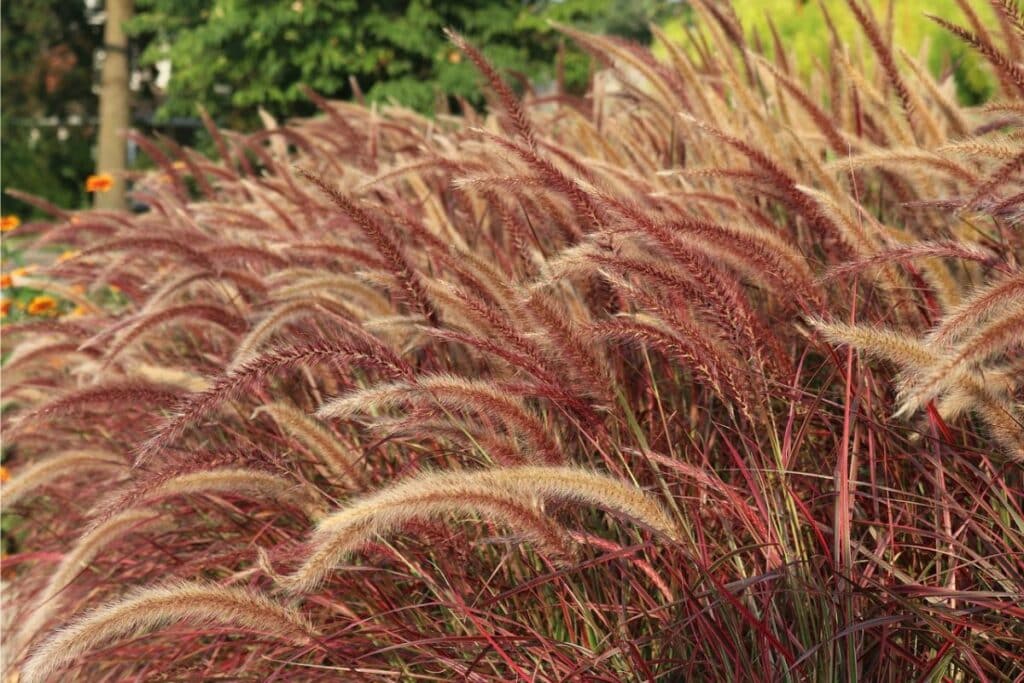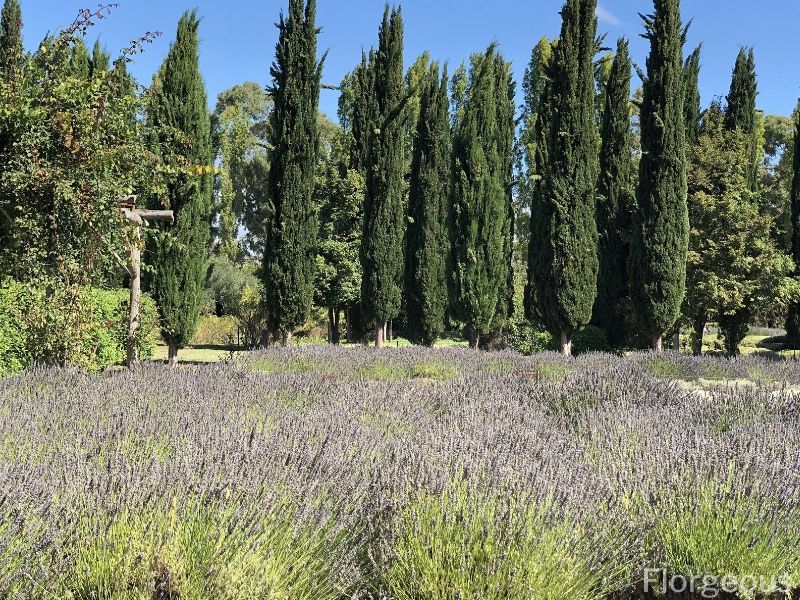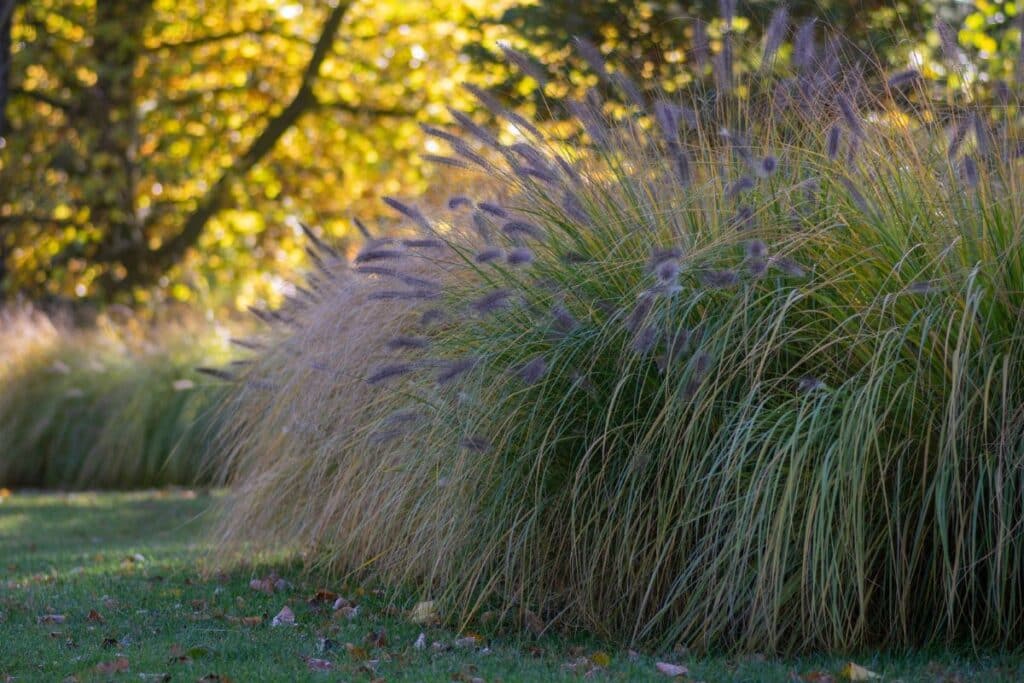Fountain grass (Pennisetum) is a perfect ornamental grass variety to select if you want to add lots of vertical interest to your garden or create a sense of movement in your landscapes.
This group of plants has many garden applications since they can be used as garden fillers, thrillers in containers, mixed borders or to form striking hedges.
Fountain grass can look a bit wild all on its own. But if you pair these ornamental grasses with companion plants like vervain, coneflowers, oxeye sunflowers, sedum, lavender, or ornamental alliums, your scapes will instantly become a lot more eye-catching.
In this guide, we are going to discuss some of the best companion plants for fountain grass and we share a couple of creative ways to use them to create showy ornamental garden features.
What to Grow with Fountain Grass

It is always best to combine plants with similar growing requirements together in your garden beds or containers. Plants with similar needs that complement one another visually are much easier to care for and they tend to grow much better in the same environment.
When it comes to growing fountain grass, it will grow well in most soil types but should be planted in full sun. These grasses can survive in partial shade but won’t flower well. They also prefer dry soil types that drain well and can be very drought tolerant.
Let’s explore some other plants that flourish in full sun and dry conditions.
Verbena
Verbena flowers (Verbena) or vervain is a companion species that will add lots of color and texture to your garden bed.
There are many different varieties of this heat-tolerant plant including perennials and annuals but even perennials are often treated as annuals because they are short-lived.
These flowering plants can grow vigorously and will quickly bloom in the first season after planting them. Vervain grows very well in warmer conditions with plenty of direct sun. They should be planted in well-drained soil and shouldn’t be watered too often.
For a striking effect, you can combine fountaingrass with a dwarf vervain or meteor shower verbena in the front as a ground cover. The bright flowers with their white to red hues will create a very interesting look in front of the fountain grass.
Some gardeners also mix tall vervain varieties among their fountain grasses to create mixed hedges or to fill out the garden.
Coneflowers
Coneflowers (Echinacea) are ideal perennials to include in your garden if you are looking for something that is hardy and bright.
The pink flowers of this medicinal plant will attract plenty of butterflies and other pollinators to your garden and will add lots of color and texture to your beds.
These tall flowers should be planted where they will receive at least six hours of full sun or they won’t flower properly. The flowers will take well to most soil types as long as the soil drains well and they can survive dry spells.
This self-sowing plant is pretty easy to grow because it will spread all over your garden on its own and only requires dead-heading if you want it to bloom more vigorously.
For a striking effect, you can mix these rosy-pink flowers all over your garden bed with clumps of purple fountain grass between and behind them.
Tuscan Sun
Tuscan sun flowers (Heliopsis helianthoides), commonly known as oxeye sunflowers, false sunflowers, or ox-eye daisies, will add lots of color to your garden with their vivid yellow flowers.
They are also great for attracting pollinating insects to your garden.
These perennials will bloom vigorously if they are planted in full sun and they can tolerate most well-draining soil types. The beautiful flowers are quite drought-tolerant and should be watered once a week.
Ox-eye can become quite tall with a height of up to 5 feet tall. Because of its height, you should plant it in clumps amongst your ornamental grasses to form a showy mixed hedge or border.
Sedum
Sedum (Sedum), or stonecrop is an ideal plant to use in your garden if you are looking for something that can tolerate drought and heat.
This flowering perennial has fleshy flat or rounded leaves that can add lots of texture to your garden. There are also 300 different species of sedum and they come in many different flower colors.
Stonecrop grows well in most well-drained soil types and they can survive with very little watering. The plants can even tolerate poor soil types or rocky soils. They prefer full sun but some species can survive in partial shade.
You can use this interesting succulent species as a ground cover in front of or around clumps of fountain grass. They will only grow up to 18 inches tall and are great for keeping the soil cool and moist.
For a more interesting color pallet, you can consider pairing fountain grass with sedum species that have colorful blooms.
Lavender

Lavender (Lavandula) is a very popular fountain grass companion plant in ornamental gardens because it smells terrific and will add lots of color to your garden with its purple flowers on tall spikes.
Lavender is perfect for dry garden spaces because it is very hardy and flourishes in dry conditions with plenty of direct sun. These flowers can grow well in any type of well-drained soil but are likely to develop root rot in clay soils or moist soils.
For a striking effect, you can plant a row of lavender in front of a row of taller fountain grass. Some gardeners also like to mix clumps of lavender and fountain grass to form a showy border or hedge alongside walkways.
Alliums
Ornamental onions (Alliums) are also great fountain grass companions because they will add lots of interest with their showy purple flower orbs. These perennial bulbs are also very easy to grow and will return to bloom each spring.
Allium bulbs will grow well in most soil types that drain well and they can survive spells of drought. In order to flower, these bulbs should be planted in full sun.
It is best to combine tall and showy allium varieties like the Star of Persia or giant alliums with fountain grasses because the purple spheres will create an interesting effect if they peek out from among the tall grasses.
What NOT to Grow with Fountain Grass
Fountain grass cannot tolerate too much moisture and won’t grow in deep shade. Because of this, it is best not to pair them with shade and moisture-loving plant species like hostas, begonias, or ferns.
Gardeners should also avoid planting them underneath any trees or shrubs that form a thick canopy.
Landscaping Ideas for Fountain Grass and Companions
After discovering so many great companions for fountain grass, it is time to take a look at some good ways to use them in your garden.
Here is a quick look at a couple of creative ideas for your mixed garden.
Dry Xeriscape Gardens
Fountain grass and most of the companions we discussed in this guide are incredibly drought tolerant. They are ideal plant species to include if you want to create a water-efficient garden.
You can mix these ornamental grasses and beautiful flowers with other natural elements like rocks, boulders, and tree stumps to create a showy xeriscape garden that doesn’t require much watering or care.
Texture-Rich Borders And Beds
Ornamental grasses are great for adding more texture to borders, garden beds, and hedges. They look especially charming if you combine them with flowering species that can help fill and brighten up these spaces.
Final Thoughts
Fountain grass has many uses in ornamental gardens. These beautiful grasses will look charming if you pair them with other ornamental species like coneflowers, ox-eye daisies, lavender, sedum, alliums, or vervain since these flowering species will add lots of color to your garden.
We hope that our guide made it easier for you to select the right neighboring plants for your garden and that you can now create showy spaces filled with movement, color, and joy.
*image by ivusakzkrabice/depositphotos







